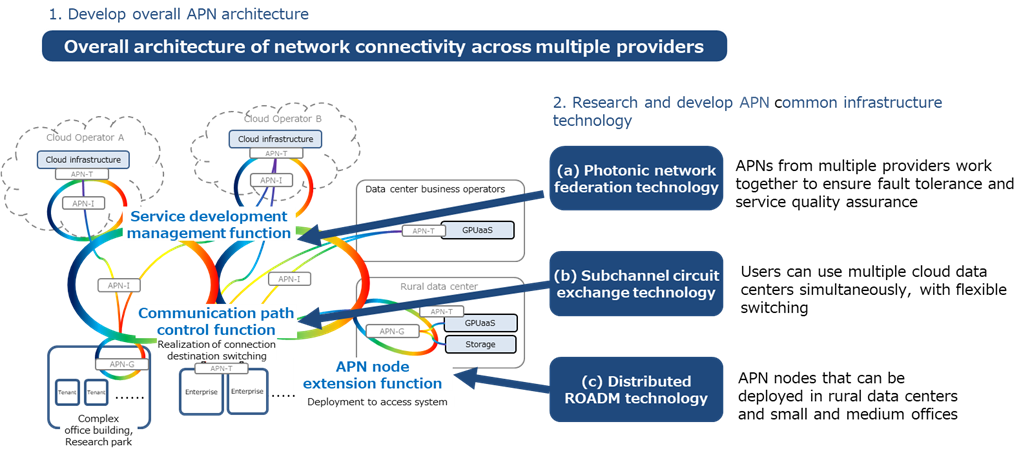Joint proposal by NTT, KDDI, Fujitsu, NEC, and Rakuten Mobile adopted as Japan's Ministry of Internal Affairs and Communications/NICT's "Innovative ICT Fund Projects for Beyond 5G/6G" for social implementation and overseas expansion oriented strategic program (common infrastructure technology establishment)
―Launched R&D to evolve APN into a network where multiple providers can cooperate to ensure E2E quality―
NTT Corporation
KDDI Corporation
Fujitsu Limited
NEC Corporation
Rakuten Mobile, Inc.
TOKYO―October 22, 2024―NTT Corporation (Headquarters: Chiyoda Ward, Tokyo; Representative Member of the Board and President: Akira Shimada; hereinafter "NTT"), KDDI Corporation (Headquarters: Chiyoda Ward, Tokyo; President, Representative Director, CEO: Makoto Takahashi; hereinafter "KDDI", KDDI Research, Inc. (Headquarters: Fujimino City, Saitama Prefecture, President & CEO: Hajime Nakamura) participating in research and development as a research collaborator, Fujitsu Limited (Headquarters: Kawasaki City, Kanagawa Prefecture, Representative Director, CEO: Takahito Tokita, hereinafter "Fujitsu"), NEC Corporation (Headquarters: Minato Ward, Tokyo; Representative Executive Officer, President and CEO: Takayuki Morita; hereinafter "NEC"), and Rakuten Mobile, Inc. (Headquarters: Setagaya Ward, Tokyo; Representative Director and President: Shunsuke Yazawa; hereinafter "Rakuten Mobile") were selected by the Japan-based National Institute of Information and Communications Technology (hereinafter, "NICT") to conduct newly commissioned research in FY 2024 pertaining to a strategic program oriented toward social implementation and overseas expansion (common infrastructure technology establishment) for the Innovative ICT Fund Projects for Beyond 5G/6G.
Through this research and development, the above parties will develop a technology that enables users to simultaneously use multiple cloud data centers and to switch connection destinations flexibly, in addition to ensuring fault tolerance and service quality assurance through cooperation among All-Photonics Networks (hereinafter "APN") of multiple providers. We will also develop a small APN node that will enable APN deployment at rural data centers and small and medium-sized sites.
In the Beyond 5G/6G era, society's informatization will accelerate further, and enormous information processing will be required. The need for APNs is growing as demand is expected to increase for the further expansion of transmission capacity and higher processing speed for existing information and communications systems, as well as for technologies that provide the lower power consumption required for carbon neutrality. Under such circumstances, discussions on providing APNs widely to society were held by Japan's Technology Strategy Committee of the Information and Communications Technology Subcommittee of the Information and Communications Council and the All-Optical Network Common Infrastructure Technology Working Group established under this committee. As a result, the idea that it is necessary to connect multiple sites simultaneously and to have functions to collaborate among providers was expressed in the reports "Information and Communications Technology Strategy Toward Beyond 5G" (June 2024) [![]() 1] and "Development Direction and Dissemination Measures for All-Photonics Network Common Infrastructure Technology" (May 2024) [
1] and "Development Direction and Dissemination Measures for All-Photonics Network Common Infrastructure Technology" (May 2024) [![]() 2]. In order to develop this technology, NICT has solicited proposals for the Beyond 5G (6G) Fund Project, to which NTT, KDDI, Fujitsu, NEC, and Rakuten Mobile jointly submitted proposals.
2]. In order to develop this technology, NICT has solicited proposals for the Beyond 5G (6G) Fund Project, to which NTT, KDDI, Fujitsu, NEC, and Rakuten Mobile jointly submitted proposals.
On October 22, 2024, the Ministry of Internal Affairs and Communications and NICT announced the results of their selection for the "Beyond 5G (6G) Fund Project" as a social implementation and overseas expansion oriented strategic program (common infrastructure technology establishment), and the above five companies were selected to implement the program.
This research and development will enable APNs from multiple providers to cooperate to ensure fault tolerance and service quality assurance, as well as enable users to simultaneously use multiple cloud data centers and switch connection destinations flexibly. The above parties are also planning to develop a small APN node, which will enable the deployment of APNs in regional data centers and small and medium-sized sites.
The following items will be addressed in this research and development:
- R&D Item 1: Develop overall APN architecture
- R&D Item 2: Research and develop common APN infrastructure technology
- (a)Photonic network federation technology
API functions for accepting communication user's requests and function for reliable and stable interconnection between APNs of various carriers according to communication user's requests (e.g. destination, communication quality). - (b)Subchannel circuit exchange technology
Enables the simultaneous use of multiple clouds and data centers as well as flexible switching, when accommodating many communication users, ensuring communication quality (required bandwidth, delay, and jitter) by E2E according to the requirements of each communication user. - (c)Distributed ROADM technology [
 3]
3]
An interface function that enables the simple operation of network nodes equipped with only a part of the main functions (wavelength insertion/branching and multiplexing functions) of the current ROADM, which enables the downsizing of APN nodes and the deployment of APN in rural data centers and small and medium-sized sites. It also provides a cooperation function between the ROADM node with the main functions and the downsized APN node being considered for installation.

When the outcomes of this research and development are implemented in society, APNs of various providers, including different communication carriers, can be used seamlessly. For example, it will enable high-speed, low-latency simultaneous connection to multiple providers that provide AI, cloud, and other services, as well as flexible selection and switching of connection destinations. The five companies will collaborate to realize such a society.
- [1]
- https://www.soumu.go.jp/menu_news/s-news/01tsushin03_02000402.html (in Japanese only)
- [2]
- https://www.soumu.go.jp/menu_news/s-news/01tsushin03_02000400.html (in Japanese only)
- [3]ROADM (Reconfigurable Optical Add Drop Multiplexing)
It is a reconfigurable node device that can add, drop, and multiplex arbitrary optical wavelengths at the optical signal exchange point.
- *The information contained in the articles is current at the time of publication.
Products, service fees, service content and specifications, contact information, and other details are subject to change without notice.
Downloads
